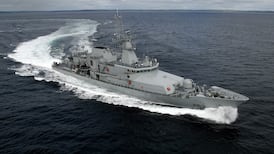I was one of a group of bleary-eyed journalists and government officials who boarded an early-morning plane at Dublin Airport 40 years ago this week, clutching an Aer Lingus ticket listing the destination as: “unknown”. We knew we were on our way to the signing of a deal between Irish and British governments on the future of Northern Ireland, but the venue was a secret.
Before the plane took off, there was speculation about whether it would be Dromoland Castle in Co Clare, Hillsborough in Co Down or even somewhere in England. As the plane headed north up the Irish Sea coast it quickly became clear that we were on our way to Hillsborough.
After landing at Belfast we were taken by bus past groups of protesting loyalist demonstrators to the pretty village of Hillsborough. We waited for hours outside the castle gates until Garret FitzGerald and Margaret Thatcher were ready for the formal signing ceremony and the subsequent press conference.
Watching the taoiseach and the prime minister putting their names to the international agreement, there was a palpable sense that we were witnessing a historic event. Although the importance of the Anglo-Irish Agreement is sometimes overlooked, it was the foundation on which all subsequent progress has been based.
READ MORE
Philip Stephens, author of These Divided Isles, a superb history of Anglo-Irish relations since 1922, said at the recent launch of his book in Dublin that the agreement was the hinge on which the peace process depended.
[ Philip Stephens: ‘I am privileged to be Irish as well as British’Opens in new window ]
The key elements were a role for the Irish government in the running of Northern Ireland and the acceptance by both countries of the principle of consent. The Irish side accepted that the North would remain part of the United Kingdom as long as the majority living there desired it, while the British agreed a united Ireland could come about if a majority in the North voted for it.
In the two years of intense negotiations leading up to the agreement, FitzGerald had pressed for joint authority over the North while Thatcher tried to limit it to a consultative role for the Irish government. In the event, the outcome was somewhere between the two, with the Irish having an official presence in Belfast to engage in the administration of the North.
The key officials who put the agreement together were cabinet secretaries Dermot Nally on the Irish side and his British counterpart Robert Armstrong. Senior officials Michael Lillis and David Goodall drove the work. This is how Goodall later explained the origins of the process. “In September 1983 in Dublin, Michael Lillis invited me to take a quiet walk with him along the Grand Canal, and proceeded to sketch out the possibility of radically new arrangements for Northern Ireland. He made it clear that these were not yet the ideas of the Irish government, but indicated that they were the lines on which the taoiseach was thinking.” Goodall rose to the occasion, briefed Thatcher, and the rest is history.
[ Forty years on, the Anglo-Irish Agreement has proved its worthOpens in new window ]
The agreement, which owed much of its inspiration to John Hume, met with intense opposition from unionists and was rejected by Sinn Féin and the IRA, which continued its campaign of violence. FitzGerald’s ability to persuade Thatcher to conclude it was a remarkable achievement, particularly given that the IRA almost succeeded in killing her during the negotiations with the bombing of the Conservative conference in Brighton.
As well as dealing with Thatcher, FitzGerald had to face the unremitting hostility of Charles Haughey, who – as Diarmaid Ferriter writes today – did everything in his power to derail the negotiations. In a move that some felt could even be described as treasonous, Haughey dispatched his deputy leader Brian Lenihan to lobby leading Irish-American politicians to oppose the agreement. House speaker Tip O’Neill and Senator Ted Kennedy angrily rebuffed Haughey’s approach but it didn’t stop him denouncing the agreement in the Dáil as the surrender of the Irish constitutional claim to the whole island of Ireland.
The cynicism of Haughey’s approach was illustrated when he took office as a minority government a little more than a year later and proceeded to use the agreement. Subsequent taoisigh Albert Reynolds and Bertie Ahern continued to build on FitzGerald’s achievement, culminating in the Belfast Agreement of 1998. They had the advantage of a patriotic opposition led by John Bruton, who backed their efforts rather than trying to obstruct them.
Haughey’s stance rebounded on him as Des O’Malley and Mary Harney voted for the agreement in the Dáil. They went on to launch the Progressive Democrats a month later and prevented Haughey winning an expected overall majority in 1987. That left him with no choice but to follow the economic and northern policies laid down by FitzGerald.
A key element of the agreement was that unionists could regain a role in the administration of the North if they accepted powersharing, and David Trimble eventually signed up. The other side of the coin was the republican movement’s ultimate acceptance of the new constitutional dispensation as the basis for ending violence. That is the enduring legacy of the Anglo-Irish Agreement.
















